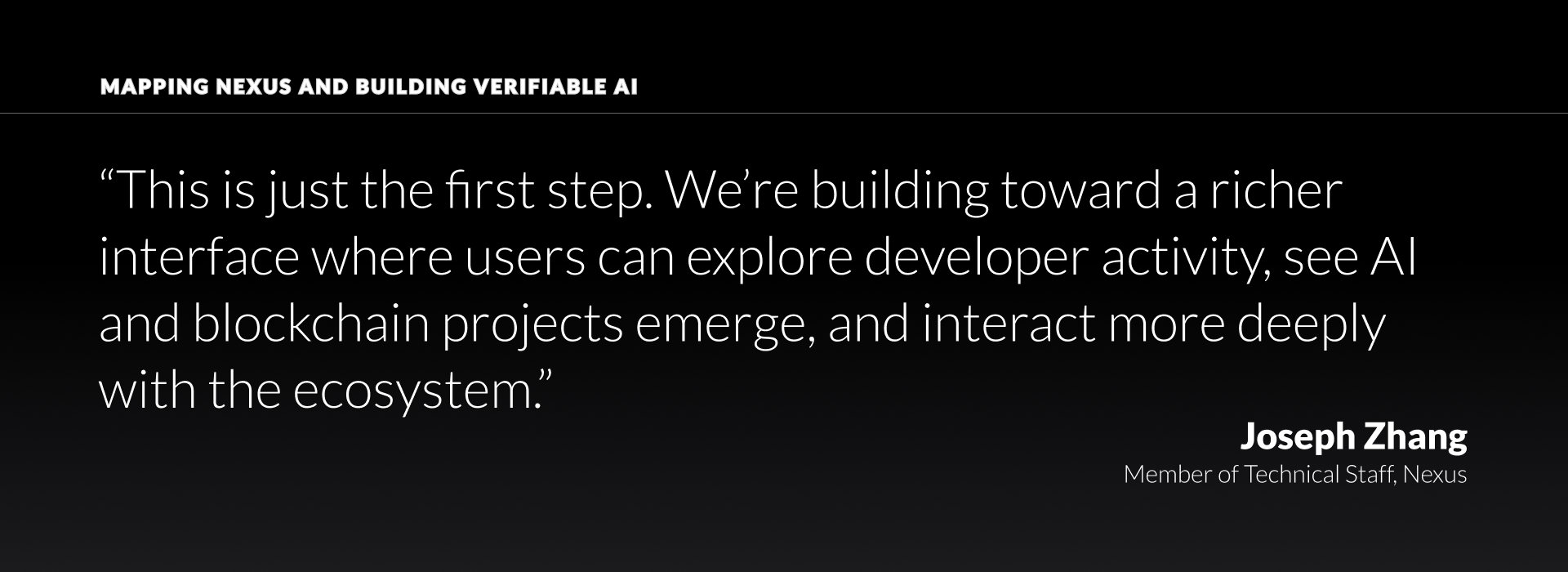A Verifiable Foundation for Financial Infrastructure
Insights from the Messari Nexus Pulse Report Finance runs on trust, but too often, that trust is unprovable. A new

When Joseph Zhang joined Nexus a few weeks ago, one of the first projects he got involved with was the launch of a global map interface for the Nexus OS. The new map, which just launched, is not just a visual — it’s a window into the scale and shape of a new kind of Internet, built on verifiability, distributed systems design, and community-contributed compute.
In a Nexus Chat, Joseph, a member of the technical staff, shared his perspective on why the map matters, where AI fits into the future of verifiable systems, and how simplicity and scale can go hand-in-hand.
Listen to the Nexus Chat with Joseph Zhang.
Joseph’s journey into technology started in a deeply interdisciplinary place: Stanford’s symbolic systems program, which weaves together psychology, philosophy, and computer science. He later completed a master’s in artificial intelligence, and before joining Nexus, worked on cloud infrastructure at Amazon and as a consultant at McKinsey.
But what drew him to Nexus wasn’t just the engineering challenge — it was the scope of the vision.
“Nexus aims to tackle zk compute accessibility, create a unified interface of proving, and expand into a consumer hub. These are intellectually stimulating problems — and they open up whole new markets.”
At first glance the new map shows where users are connecting from around the world. But behind that simplicity lies a larger goal — making the scale of the Nexus network tangible.
“We wanted to visualize interconnectivity. We’re building an ecosystem where developers, hobbyists, and compute suppliers all interact, and the map gives people a sense of how global that ecosystem is already.”
The map aggregates that participation across more than 1,400 cities, highlighting hotspots of activity in places like India, China, and West Africa. In the coming months, as smaller cities cross key participation thresholds, the network’s reach will become even more visible — particularly across emerging regions like South America.
While the map shows where activity is happening, it doesn’t reveal anything about who is participating. Privacy is protected by design: location data is aggregated at the city level, and no personally identifiable information is ever collected.
“Roughly 20% of our users opt to stay completely anonymous. We’re using browser-based city aggregation. So while we might know there are a thousand users in San Francisco, there’s no street-level detail, and nothing that’s traceable.”

The map marks a shift in how users can experience Nexus. The network has always been easy to access — one click to connect, contribute compute, and start earning rewards — but until now, much of that participation has been invisible. The map changes that. It introduces a layer of community and visibility that makes participation more concrete.
“This is just the first step. We’re building toward a richer interface where users can explore developer activity, see AI and blockchain projects emerge, and interact more deeply with the ecosystem.”
Joseph’s background in AI also plays directly into what’s next at Nexus. With the launch of the Verifiable AI Lab, the team is beginning to integrate AI into both the network interface and its underlying architecture.
There are two main directions:
“Even a year ago, some of this wouldn’t have been feasible. Now, we’re building verifiable systems that can make AI smarter—and more trustworthy—at scale.”
For Joseph, the excitement lies in how these layers come together. A real-time map. A verifiable network. AI-powered infrastructure. All wrapped in a simple, accessible interface.
It’s not just about seeing the network — it’s about understanding your place in it.
“People see the map and say, ‘Oh wow, the system is really big.’ That moment of recognition…that you’re part of something global… that’s what we’re designing for.”